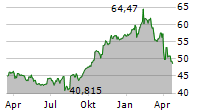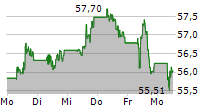NORTHAMPTON, MA / ACCESS Newswire / September 23, 2025 / Cisco Systems Inc.
By Nicole Kenney

Sustainability 101 is a blog series that you can turn to for information about different environmental terms that may come up at work, during discussions with friends, and even at your family gatherings.
Whether we're purchasing grocery items wrapped in plastic or receiving a home shipment packed in polystyrene peanuts, packaging is part of our everyday lives. However, much of it becomes waste after one use.
According to the Organisation for Economic Co-operation and Development (OECD), 31% of plastics produced are for packaging - often single-use and with an average six-month lifespan. Plastic is widely used as an effective packaging material, but as waste in the environment, it can have a negative impact.
Research published in the November 16, 2024, Journal of Hazardous Materials Advances shows that that in landfills, plastic can emit toxins and become a source of greenhouse gases (GHGs), and in oceans, it can break down into microparticles that could disrupt food chains and contribute to a variety of health disorders.
Some other non-recyclable or non-compostable packaging items include foam, aluminum foil with food residue, and fused components such as cardboard attached to foam that cannot be easily separated for recycling.
How does this influence consumers' choices? A 2025 McKinsey & Company survey reports that 77 percent of respondents consider recyclable packaging "extremely important" or "very important," while 62 percent responded the same about packaging made from recycled materials.
Packaging sustainability: Materials matter
In a circular economy, industries adjust their processes to enable the reuse and regeneration of materials. The goal is to make products with the smallest environmental impact using the fewest resources possible.
By focusing on materials, companies can make their product containers and components more sustainable, such as berry growers using compostable trays or cosmetics manufacturers using refillable containers for post-purchase reuse.
Some other strategies include:
Reducing or eliminating unnecessary components
Using QR codes to digitize information vs. printed materials
Incentivizing consumer recycling with rewards or by providing clear instructions on how to recycle
Using these alternatives can help reduce packaging waste while aligning with customer values. It also can help reduce packaging costs, optimize space efficiency, and build in regulatory compliance.
How Cisco's strategy has evolved to think "inside the box"
For Cisco, packaging sustainability is the practice of minimizing waste by reducing or removing certain materials - such as single-use plastic bags and foam - and replacing them with alternative materials that are renewable, recyclable, or both.
In 2019, Cisco developed a set of Circular Design Principles for its products across five categories - one of which is packaging and accessories. Product teams and packaging engineers in our Supply Chain Operation team collaborate at the outset of the design phase to craft a package that provides the optimal balance of product protection and circularity. Many of our products now incorporate recyclable fiber-based cushions like FiberFlute®, paper tube cushions, and molded pulp to replace foam. Through Cisco's No Paper Initiative, QR codes for digital product information avoid material use altogether.
A good example is the Cisco Ceiling Microphone Pro package, which is fully fiber based. Instead of plastic trays, we opted for unbleached molded pulp-fiber trays that are strong enough to cushion the fragile unit, yet light enough for cost-effective shipping. We also swapped out the conventional single-use plastic bag with a custom-fit paper sleeve that fully encases the unit and shields it from dust and abrasion.
Packaging from legacy products can be modified for circularity as well, and Cisco's Catalyst 9300 Enterprise Switch is a prime example.
To replace foam, we used recycled thermoforms to cushion the chassis - eliminating about 250 metric tonnes of foam annually - and recycled and recyclable fiber-based retention packs for the power supply units - avoiding approximately 70 additional metric tonnes per year. To eliminate plastic bags, we opted for paper flag labels on power cords, consolidated small parts across multiple bags, and swapped out plastic for paper-based envelopes. In fiscal 2025, Cisco applied these packaging changes to the new generation Cisco C9350 smart switches.
Packaging sustainability: A Circular Design Principle
Circular Design Principles have transformed the product and packing design process at Cisco. Other examples of how we incorporate circularity into our packaging include:
Reducing materials usage with a heightened focus on plastics reduction
Designing containers and packing materials to be separable and easily recycled at end of use
Using post-consumer waste in new packaging parts
Eliminating paper documentation in new product shipments
Reducing the shipment of unused accessories by offering our customers an opt-out option during the ordering experience
Using multipack solutions to reduce material usage and bundling containers for large shipments to reduce the number of boxes needed
By using more efficient, renewable, and recyclable materials, Cisco not only helps keep waste out of landfills but reduces costs and saves resources.
Learn more about these initiatives and Cisco's packaging sustainability goals in the Cisco Purpose Reporting Hub.
View original content here.
View additional multimedia and more ESG storytelling from Cisco Systems Inc. on 3blmedia.com.
Contact Info:
Spokesperson: Cisco Systems Inc.
Website: https://www.3blmedia.com/profiles/cisco-systems-inc
Email: info@3blmedia.com
SOURCE: Cisco Systems Inc.
View the original press release on ACCESS Newswire:
https://www.accessnewswire.com/newsroom/en/industrial-and-manufacturing/sustainability-101-at-cisco-what-is-packaging-sustainability-1077197



